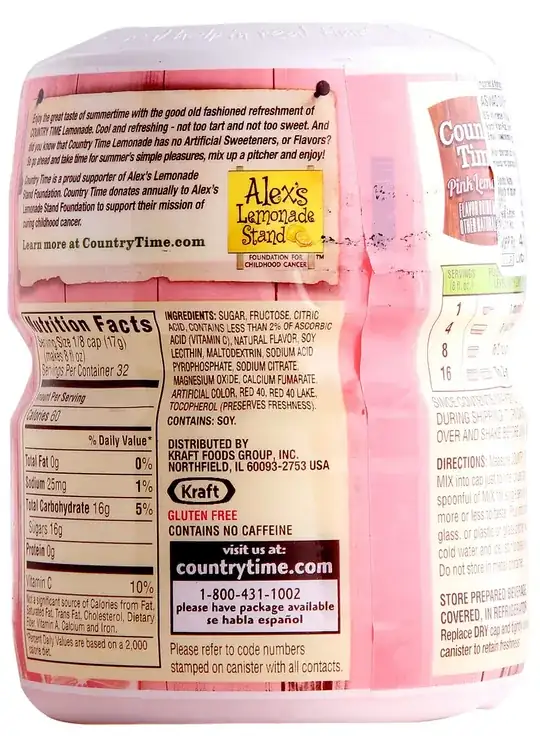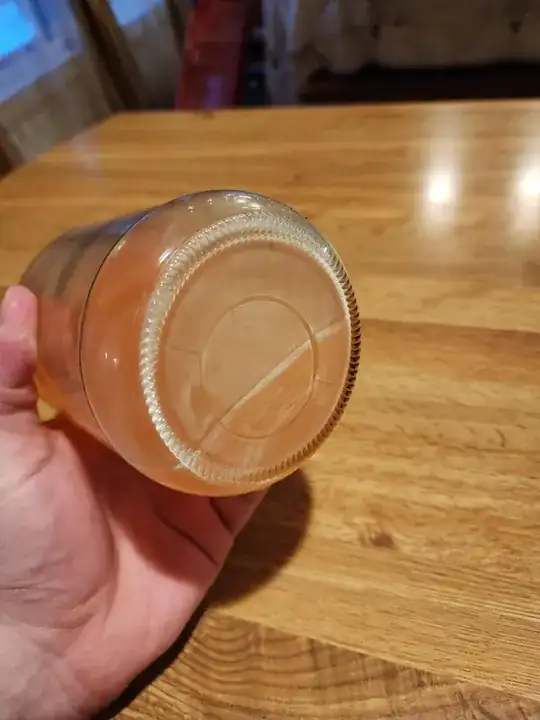First of all, relax. It's not going to hurt you.
What it's not:
- Mold
When a food is contaminated with mold, typically the visible portion of mold (but importantly not the only portion that has grown and contaminated your food), is found on the surface. In drinks it often has a spongy texture and would generally not settle to the bottom unless shaken thoroughly. It also will not generally have a sandy or powdery texture, which best as I can tell from that picture, is what you've got above. While there are molds that vary beyond what I've described here, your drink has not molded.
- Microplastics
Microplastics come in two classifications: primary and secondary. Primary are the larger of the two, anything 5mm in size or less, and you would generally be able to discern without much difficulty if plastics of this size were contaminating your drink, certainly they wouldn't have needed time to settle before being noticed. The smaller microplastics, secondary ones, are what happens when sources of primary (or larger) micro/plastics break down, from processes like natural weathering or going for a wash in a laundry machine. These smaller secondary microplastics are not typically visible to the naked eye. I suspect as well that they would be likely to stay suspended, being very small and (most probably) neutrally buoyant. In any case, as Rumtscho mentioned in his comments, it would be a very serious problem if something like this went wrong during manufacturing. Not that it doesn't, but it's likely not this.
What it probably is:
- Insoluble Compounds
As dbmag9's answer mentions, this is a possibility. However I find it unlikely, personally, that there are many insoluble compounds in a powder designed to dissolve readily in water. These would make up a significantly smaller portion of ingredients list. From the ingredients I was able to find online, magnesium oxide is one such insoluble ingredient. I think it's reasonable to say some of the precipitate may be insoluble compounds, but personally it's much more likely to me that a majority of it is...
- Soluble Compounds
The main ingredients in Country Time Lemonade are all readily soluble in water: sugar, fructose, citric acid, ascorbic acid, and sodium citrate all dissolve. I suspect several of the others do as well, though have not bothered to confirm as much for each item listed in the ingredients. If you're not bothered by tasting it, you could attempt to isolate a portion of the lemonade which has fallen out of solution and compare its smell and flavor to that of the original powder and of the completed drink. It should carry a similar, although perhaps not exact, flavor depending on which ingredients precipitated out at what rate.
So why are the soluble ingredients falling out of solution?
There's several possible culprits, and the likeliest is a mix of these and perhaps more things I haven't accounted for:
- Lack of turbulence
When we shake or stir something, we help to suspend the insoluble ingredients, and aid in soluble ingredients dissolving. We're both adding energy to the drink through mechanical action and breaking down the clumps. Any excess of the soluble compounds will join the insoluble ones in solution. As it is left undisturbed, however, it settles back down to the bottom. The solution is one you already employ: shake or stir before you consume it.
- Saturation
It's possible that at the ratio of water to powder that you use, the water is fully or nearly fully saturated. This would make it so that as conditions change to make the water to powder ratio even more extreme the soluble ingredients would begin to precipitate out of solution. This would happen even more quickly if the ratio used is such that there is an excess of soluble ingredients, as there would be no need for the ratio to change for some of the soluble ingredients to precipitate out. A possible solution for this would be to adjust the ratio of water to powder to use somewhat less powder, and see if you still enjoy it equally.
- Evaporation
So why is it that the water to powder ratio is changing? Over time the water will evaporate, especially true in warm settings but it remains true inside of a fridge, and even if covered, so long as the cover isn't air-tight. You're already doing at least some of what you can to account for this: keeping it in the fridge. In addition, ensure it's covered as tightly as is reasonable and, if the problem happens, you could add a little water to dilute it. Overall though, I think this is likely to be one of the smaller factors unless you're making up very small batches and leaving it sitting out somewhere warm and sunny for a few hours.
- Temperature
We can experience a similar effect as with evaporation even if the water to powder ratio stays the same. If the water's ability to hold ingredients in solution goes down, the end result is the same as if we had less water. And temperature is a major factor in water's ability to hold something in solution. When making a simple syrup (sugar and water), for instance, we heat it on the stove to help easily dissolve everything. Same with adding salt to water used to make pasta, if you add it while the water is cold it will take longer for it to dissolve than if you add it while hot. Ingredients generally have an easier time dissolving into water when they are warm. And as those ingredients and the water are chilled in your refrigerator, what once was easily soluble will begin to precipitate out. Stirring should mostly help to dissolve this through introduction of energy, but letting it sit out a little while before you drink it is another way to fix this. You could also make it as needed and chill with ice, instead of in bulk.
Your best option, in my opinion, is to do what you already do: shake or stir the ingredients back into solution/suspension and enjoy. But feel free to play around with any of the other offered ideas to see what you like best.


